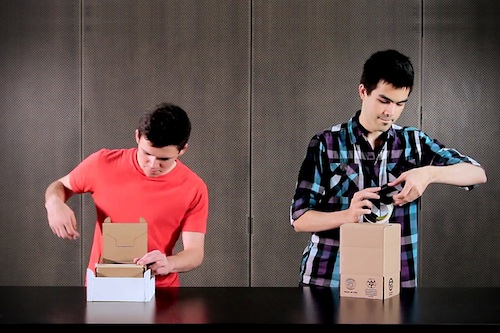Henry Wang and Chris Curro of Cooper Union went and did the damn thing: they created a better, more effective cardboard box. This isn’t something that people often think of, but we use cardboard boxes for (a) basically every Amazon purchase out there and (b) every time we move, so … it would be cool if we could see some innovations in this field, no? (Do you know how many cardboard boxes are made in just the U.S. every year? Guess. I’ll wait. OK, it’s more than 100 billion.) The Rapid Packing Container in question uses 15-20% less cardboard than a box you’re accustomed to seeing, but still has a 260-pound carry ability (that’s a lot of ol’ college textbooks you’re hanging onto for reference right there). Here’s how it basically works, Part 1:
Before they are taped together, most cardboard boxes have two open ends: top and bottom. The bottom is reinforced with twice as much cardboard when folded to make it strong enough to support the content of the box’s load weight, even though tape might be the only thing holding it closed. Wang and Curro realized that by designing their Rapid Packaging Container so that the bottom of the box was a single, structurally-sound piece of cardboard, they could eliminate a lot of waste.
And here’s how it works, Part 2 (the reveal):
Instead of ripping open a taped-together cardboard box, opening a Rapid Packaging Container is as simple as pushing a tab on the top of the box and having the whole thing unfold itself flat again before your very eyes. Even better, it’s fully reversible, meaning that if you receive one in the mail, you can just turn it inside-out for a label free box that you can then send to someone else.
Whoa.
This is big — or could be. There’s a patent pending. Maybe these two can get on pizza box design too; that’s a seemingly emergent market. Or, you know, movie re-creation.
In case you wondering how a standard cardboard box is made, there’s this:
Not everyone is bullish on the box, though:
I see manufacturing issues in die cutting, and it would eventually cost the same.
The Rapid Packing Container http://t.co/SyCQN6DbgK
— Waleed 📷 وليد الزهير (@65WZ) January 1, 2014
Two cool things about this: (a) Who honestly thinks that their brain power is best spent on re-doing the cardboard box? That’s inherently awesome. Thank you for not attempting to design another app where animals fight or something, and instead make it easier for me to move the next three times I do, because that process is abject hell and (b) it’s good to see that the spirit of innovation, despite every business journalism narrative of the past seven years, is still alive and well in some American colleges and universities.
